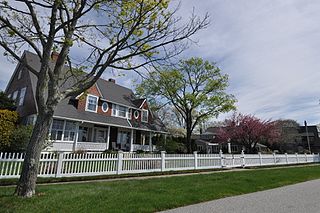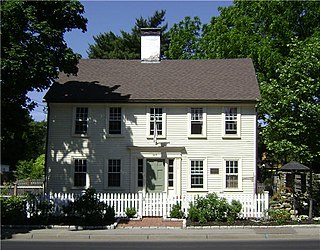
The Benjamin F. Greene House is an historic house at 85 Cross Street in Central Falls, Rhode Island, USA. The Second Empire house was designed by Clifton A. Hall and built by Wheeler & Marchant in 1868. The house is one of a small number of high-style mid-19th century houses in the city. It was built for Benjamin Franklin Greene, a second-generation mill owner in the Central Falls/Pawtucket area.

The Greene Inn was a historic summer resort hotel at 175 Ocean Road in Narragansett, Rhode Island.

Windmill Cottage is a historic house and former windmill at 144 Division Street in East Greenwich, Rhode Island. It was the home of George Washington Greene, a former American consul to Rome and historian. It was purchased for Greene by his friend, the poet Henry Wadsworth Longfellow.

Budlong Farm is an historic farmhouse in Warwick, Rhode Island. It is a 1+1⁄2-story wood-frame house, with a gambrel roof and a large central chimney. Its current entrance is asymmetrically placed on the north facade, although the original main entry was on the south side. The house was probably built sometime between 1700 and 1720 by John Budlong, whose family was one of the first to settle the area after King Philip's War. The property is a rare local example of architecture to survive from that period.

Buttonwood Beach Historic District is a historic district bounded by Brush Neck Cove, Greenwich Bay, Cooper and Promenade Avenues in Warwick, Rhode Island. Buttonwood Beach is a bucolic neighborhood on the eastern limb of the Nausauket neck, located in the West Bay area of Warwick, Rhode Island. Buttonwoods is delimited by Nausauket and Apponaug to the west, Buttonwoods Cove to the north, Greenwich Bay to the south and Oakland Beach to the east. Buttonwood Beach was founded as a summer colony in 1871 by the Rev. Moses Bixby of Providence's Cranston Street Baptist Church, who was looking for a place to establish a summer colony by the shore for his congregation. He envisioned a community that would be similar to Oak Bluffs on Martha's Vineyard, where the Methodists established a summer campground in 1835. Today, this coastal neighborhood on Greenwich Bay is home to people from many different religious backgrounds.

The Cowesett Pound is an historic animal pound on Cowesett Road in Warwick, Rhode Island. The pound, a roughly square structure built of unmortarted fieldstone four to five feet in height, is estimated to have been built in 1742 by David Greene, although there was an older pound already at the site. Its walls were probably once topped by capstones, but only one of these survives. The entrance to the pound has a wooden gate added during a 20th-century restoration.

Forge Farm is an historic farm in Warwick, Rhode Island. Established in the mid-17th century by the Greene family, it is one of the oldest farms in Rhode Island. It was the birthplace of General Nathanael Greene, a prominent American general in the American Revolutionary War. The core of the main house was built in 1684 by James Greene, son of John Greene, who purchased the land from local Native Americans. It has been extended and altered numerous times in the 18th and 19th centuries. Nathanael Greene was born in this house in 1742, and the farm was owned for many years by Nathanael's brother Christopher, and wife, Deborah (Ward) Greene, daughter of Continental Congress member Samuel Ward.

The Forge Road Historic District is a historic district on Forge Road from Ives Road to the Potowomut River in Warwick, Rhode Island. Most of the district's nearly 200 acres (81 ha) are taken up by the Forge Farm, which lies south of Forge Road, is one of the oldest farms in Rhode Island, and was the birthplace of American Revolutionary War general Nathanael Greene. A memorial to Greene stands near the bridge crossing the Potowomut River. Opposite the farm on Forge Road stand four houses, all of which date to the late 18th to mid-19th century.

Captain Oliver Gardiner House is a historic house prominently located in Warwick, Rhode Island. Built about 1750, it is a 2+1⁄2-story wood-frame structure with a gambrel roof. Its main facade has six irregularly-spaced bays, with a centrally positioned entrance. The house is unusual for its period in that it has a large central hallway, a feature not commonly seen until the Federal period. Oliver Gardiner, its first owner, was a ship's captain.

The Caleb Gorton House is a historic 18th-century house located in Warwick, Rhode Island.

The Caleb Greene House is an historic house in Warwick, Rhode Island.

The Moses Greene House is an historic house in Warwick, Rhode Island. It is a 2+1⁄2-story wood-frame house with a large central chimney, and a rear ell. The main block was built c. 1750, and is one of Warwick's few surviving 18th-century houses. It is located on one of the first sites to be occupied by European settlers in Warwick, near one of its first sawmills. In 1750, Moses Greene built his home where Buckeye Brook meets Mill Cove. The home may have served a role in the Underground Railroad—a secret cellar room is accessed by a stone wall that slides aside on iron tracks. The room may have also been used by rum smugglers. The house was listed on the National Register of Historic Places in 1983.

The Peter Greene House is a historic house in Warwick, Rhode Island. The 2+1⁄2-story wood-frame house was built c. 1751, probably by the sons of a militia captain named Peter Greene, and is a rare surviving 18th-century house in Warwick. It has a five-bay facade with a plain door surround, a central chimney, and a rear ell.

The Green–Bowen House is a historic house at 100 Mill Wheel Road in Warwick, Rhode Island, United States. It is a late-date stone-ender house, built c. 1715, and is the oldest surviving house of the locally historically prominent Greene family. It stands on land purchased by John Greene from local Native Americans in 1642, and was probably built by Fones Greene not long after he acquired the land in this area in the early 18th century. The house has a two-story main block, with two rooms on each floor, and its west wall and chimney are built of brick instead of stone. Shed-roof additions dating to 18th century were added abutting the west side and the rear. The property it stands on includes a 20th-century house, and a 19th-century barn and cottage.

The Greene–Durfee House is a historic house at 1272 West Shore Road in Warwick, Rhode Island. The house, a 2+1⁄2-story wood-frame structure with a large central chimney, stands set well back from the west side of the road, opposite Church Avenue and a small cemetery. It is set behind a small wood-frame commercial building and is partially screened from view by bushes. Built c. 1780, it is one of the city's finest Georgian style houses, with a particularly well-preserved interior.

The Kent County Courthouse, now the East Greenwich Town Hall, is a historic court building at 127 Main Street in East Greenwich, Rhode Island.

The Oliver A. Wickes House is a historic house in Warwick, Rhode Island. The two-story stone structure was built in 1855 in a vernacular Federal/Greek Revival transitional style. The house is the only known period stone house in Warwick, and one of a very small number in the state. It has a four-bay main facade with a recessed entry framed by sidelights and a transom window.

The John R. Waterman House is an historic house at 100 Old Homestead Road in Warwick, Rhode Island. The 2+1⁄2-story wood-frame house was built c. 1800 by John R. Waterman, a prominent local farmer and politician. Waterman played a significant role in what became known as Dorr's Rebellion, an ultimately successful attempt to force liberalizing changes to the state constitution. The house is an excellent local example of Federal style, and is locally distinct for its use of paired interior chimneys instead of a large central one.

The Valley Queen Mill is an historic mill at 200 Providence Street in West Warwick, Rhode Island.
Greene House may refer to:





















